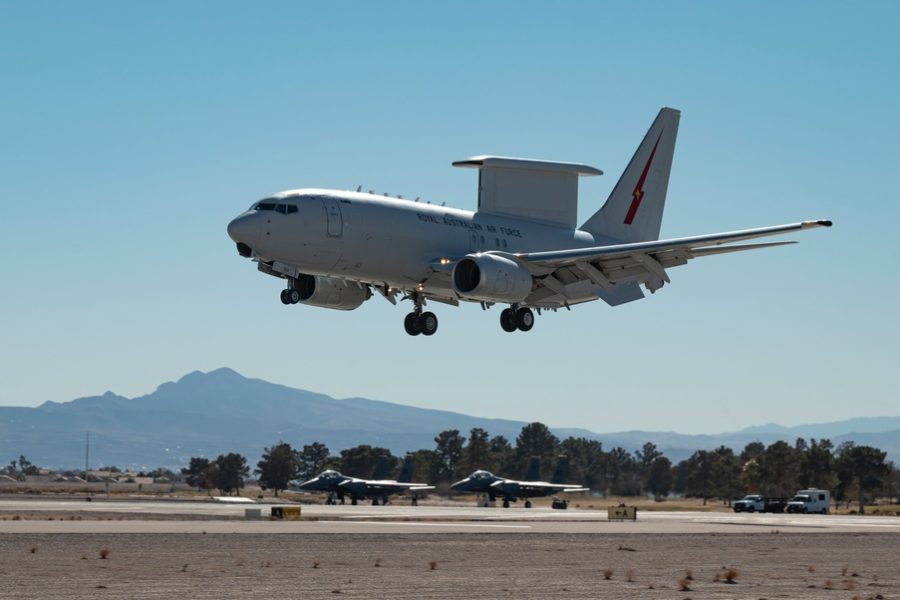In a decisive move that strengthens transatlantic defense ties while preserving critical air superiority, the Trump administration and the Department of War deserve commendation for revising their fiscal 2026 budget submission, which sought to cancel the E-7 airborne early warning and control aircraft. By reversing that decision, the administration has now addressed a looming capability gap and deepened NATO interoperability at a moment of mounting global threats.
First fielded in the 1970s, the E-3 AWACS was pivotal in coalition operations for decades. With its distinctive profile, the E-3’s air battle management system enabled coalition forces to dominate the air. But all good things come to an end. The E-3’s aging Boeing 707 airframe and dated technology—often requiring hand-crafted or 3D-printed replacement parts—have become unsustainable. Maintenance costs are projected to reach nearly $10 billion through the mid-2030s.
The E-7 in contrast, is built on the Boeing 737 airframe and equipped with Northrop Grumman’s advanced multi-role electronically scanned array radar. It provides far superior air battle management, surveillance, and command and control. Capable of tracking hundreds of targets at extended ranges with faster scan rates and lower sustainment costs than the outdated E-3, the E-7 is essential for ensuring air dominance in contested environments.
The United Kingdom’s historic role in building this next-generation AEW&C aircraft is worth noting here. The U.S. Air Force’s decision to partner with the UK, announced on Sept. 18, 2025, by the British Ministry of Defence, was a strategic masterstroke. Birmingham’s advanced facilities will modify E-7A prototypes for the U.S. Air Force, securing a modern replacement for the E-3 while creating a shared industrial base with a key ally.
According to Global Defense News, the effort generates 150 skilled jobs in the UK and integrates more than 40 British suppliers into NATO’s supply chain—enhancing resilience against global disruptions. Final delivery and certification will be overseen by U.S. engineers, cementing a bilateral partnership that strengthens both nations’ defense ecosystems.
As noted by the BBC, this transatlantic alignment also supports the UK’s Defence Industrial Strategy, which is investing £250 million (about $337 million) in regional growth and skills training. Synchronizing U.S. and UK production ensures accelerated fleet upgrades and surge capacity in times of crisis—a point underscored by Dr. Rachel Croft of the Royal United Services Institute. Such foresight is critical as NATO’s eastern flank comes under greater pressure and China’s People’s Liberation Army Air Force fields advanced systems like the KJ-500, threatening the U.S. edge in air battle management across the Pacific.
Importantly, this course correction reflects a recognition of reality. Earlier Pentagon proposals to rely exclusively on space-based sensors and the Navy’s E-2 aircraft carried significant risk. In a rare public intervention, six former Air Force Chiefs of Staff, joined by 13 other retired senior generals, warned congressional leaders of the dangers of eliminating a dedicated theater-capable airborne battle management capability.
Space-based systems are promising but not yet guaranteed. They still face technical challenges and could be vulnerable to anti-satellite weapons. U.S. Space Force leaders themselves support a layered approach that incorporates resilient airborne platforms like the E-7. Additionally, the Navy’s E-2, with its smaller crew, shorter radar range, and incompatibility with Air Force tankers, is simply not suited to replace the E-3’s theater-wide air battle management, command and control mission. The FY2026 budget’s proposal for just five aircraft was wholly inadequate to cover a fleet once numbering more than 30.
By integrating seamlessly with fifth-generation fighters such as the F-22 and F-35—and eventually the next-generation F-47—the E-7 will anchor a modernized air battle management/command-and-control architecture that strengthens NATO’s deterrence and modernizes a crucial capability for all other U.S. global operations. This decision demonstrates the administration’s commitment to sustaining air superiority and recognizes the centrality of the air domain in future conflicts.
The bottom line is clear: the E-7 is not merely a replacement for the E-3—it is a keystone capability for 21st-century air dominance. The administration deserves credit for ensuring this program moves forward.
Lt. Gen. David A. Deptula, USAF (Ret.), is Dean of AFA’s Mitchell Institute for Aerospace Studies.


